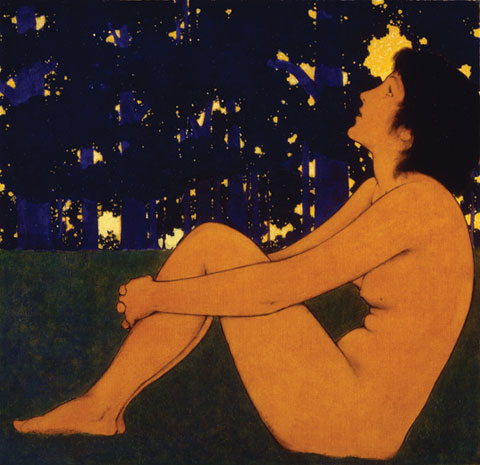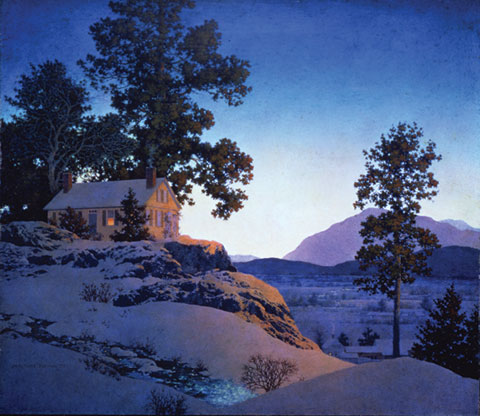
ICONIC Century Midsummer Holiday Number. |
An otherworldly light glows from Maxfield Parrish's paintings — part golden sunset, part moonlight, part fairy dust. It gives his paintings of dreamy women, wandering knights, Greek gods, fabled Bagdad merchants, and uncannily still landscapes an air of romance and mystery.
As Modern art was transforming reality into the urgent flaming brushstrokes of the Fauvism and the cracked planes of Cubism, "Maxfield Parrish: The Retrospective" at the National Museum of American Illustration (492 Bellevue Avenue, Newport, through September 2) seems to reveal a resolutely conservative realist artist. In some ways, these painters were all responding to the rise of photography in the 19th century. The Modernists seemed to ask: If cameras could be so true to reality, why not just leave realism to photographs? But for Parrish, one of the most beloved illustrators of his era, the camera was a tool he used to crack open windows onto dream worlds.

CALM Evening Winterscape. |
Parrish (1870-1966) was born in Philadelphia, the son of a landscape painter and printer, and studied at the Pennsylvania Academy of Fine Arts (where he later taught) and briefly with the celebrated illustrator Howard Pyle. He began selling his work before settling in what he called the "paradise in the mountains" of Plainfield, New Hampshire, near the artists' colony of Cornish, in 1898. Parrish had established himself with his first cover commission — for Harper's Bazaar — in 1895. A decorative design (not seen here) of a pair of women in flowing patterned gowns amidst flowers and an Old World landscape, it reveals the inspiration that the young Parrish drew from the 19th-century Pre-Raphaelites and Arts and Crafts Movement, both based on reclaiming the awesome traditional handcraft of medieval Europe and dreams of an idyllic past as their contemporary world was embracing the mass production of the Industrial Revolution.
An iconic work here is Century Midsummer Holiday Number (1896), a poster for Century magazine featuring a golden nude woman seated in profile, with her arms around her knees, staring up into the sky, from a lawn before a purple and green wood. Parrish's paintings would grow increasingly complex and photographic, but already here you see the primary ingredients of his style: eye-popping color, idyllic landscapes, and scantily-clad ladies seemingly glimpsed unawares in states of reverie. He also amused with comedic trollish men, as in Jack and the Giant (1908), which depicts a grinning lunkhead giant holding a tiny hunky Jack in his hand.
Parrish's work appeared in books, posters, calendars, magazine covers, and "fine art" prints. By 1925, one of his publishers estimated that reproductions of his most popular print could be found in one in four US households. It was hailed as "democratic" art for the American public.